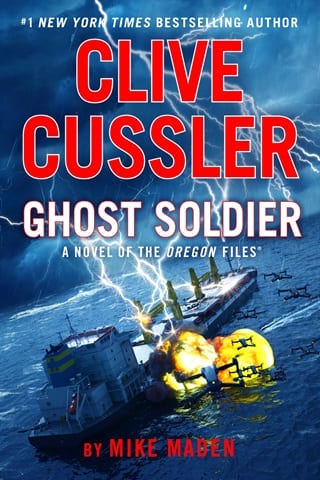Chapter 25
25
Aboard the Spook Fish
In the Gulf of Oman
“Approaching maximum test depth. Estimated time: thirty seconds.”
A soft chime accompanied the automated feminine voice as it repeated the message. The warning display panel flashed 4,000 feet the Spook Fish’s maximum test depth, an engineering euphemism for crush depth.
Callie silenced the alarm.
The Spook Fish’s cockpit was incredibly quiet in part because it was well insulated against the frigid temperatures and hull-crushing pressure of the sea. The low hum of the electrical motors was barely noticeable even when the thrusters spun up their revolutions for small maneuvers. Comms weren’t necessary. The cabin was so small and quiet that passengers only whispered to be heard. The intense quiet magnified the startling creaks and thuds of the pressurized hull equalizing itself as the Spook Fish descended into the depths.
Their only communication with the surface was through short text messages via low-frequency acoustic modems and a buoy relay.
“Isn’t the name of your boat the Spook Fish 5000?” Linda asked.
“Yep.”
“I assumed the ‘5000’ stood for a five-thousand-foot operational depth. But we just alarmed at four thousand feet.”
“Yep.”
“So why is it named the Spook Fish 5000?”
Callie shrugged. “The Spook Fish 4000 just didn’t sound as good in the marketing materials.”
“Next time bring your marketing department down here. They might rethink that.”
“I am the marketing department,” Callie said. She shot a wink at Juan just as a thundering “pop” hit the hull.
Juan chuckled. “Reminds me of Das Boot, but without the depth charges.”
Linda and Juan weren’t terribly bothered by the descent into the stygian dark, though neither of them had even been close to this depth. Both of them were expert sub handlers. The Nomad was capable of diving to one thousand feet, though they rarely took her down that far.
They had, however, exchanged a couple of sidelong glances along the way down. Their mutual unspoken concern during the descent was Callie’s complete reliance on her AI-powered piloting and navigation system.
To Callie’s credit, the AI navigation worked perfectly. Its specialized sensors instantly acquired and honed in on the flight data recorder’s underwater locator beacon pinging at 37.5 kHz once per second. The beacon had thirty days of battery life, so there was no danger in losing the signal anytime soon.
So far, so good.
Juan’s fingers twitched occasionally, his subconscious mind craving the security of human hands on a yoke. He knew that numerous studies had shown that humans were far more dangerous behind the wheel of a car than any self-driven system. He also knew that the most common reason for airplane crashes was pilot error.
But Cabrillo was old-school. As impressed as he was with the performance of Callie’s automated vehicle, he felt more human in the analogue world. It seemed as if machines were taking over nearly every human activity, and in so doing were taking control of human destiny.
Callie sat in the middle seat between Juan and Linda in front of the pilot’s touchscreen station, her primary interface with the Spook Fish. For backup there was also a pilot’s yoke and throttles. There was also a pair of joystick controls for the drone.
All three had a front-row seat to the view outside—not that there was much to see. No sunlight penetrated down this far. They had passed into the lightless bathypelagic zone some eighteen minutes earlier. Linda thought it looked like they were driving through a midnight blizzard in Montana. The Spook Fish’s bright, high-intensity LED lights illuminated a wall of constantly falling “marine snow” comprised of clumps of dead microscopic organisms, sand particles, and even fish feces originating in the water layers above.
Linda noted the digital clock. They had been descending for an hour and three minutes. The Spook Fish was zeroing in on both the sonar imagery of the tail section and the underwater location beacon signal. Callie used their descent for training time for Linda, who would be the submersible’s primary operator when it was eventually turned over to the Oregon, though Juan was paying close attention. They had trained on the simulator software Callie provided several days before her arrival, but in truth the navigational computer did all of the work. The only role a human pilot had was to set up the mission parameters, communicate with the surface, and provide emergency backup if needed.
The softly thrumming engine motors ceased their operations just as the computer voice announced, “Warning. You are at maximum test depth of four thousand feet. Do not proceed further. Do not proceed further.”
Callie killed the verbal alarm, but the text warning still flashed on the navigation console in bright red letters.
The marine snow fell beyond the optically perfect acrylic bubble surrounding them. The Spook Fish’s thrusters fought to maintain its position in the slow-moving currents.
“Well, we’re at the end of the line,” Callie said. “Now the fun begins.”
★Today was as much a test for Juan and Linda as it was for Callie’s submersible. They would be the ones to pilot the Spook Fish on the deepwater adventures Cabrillo planned for her. He often thought of his need for a vessel with the combined automated features and extreme depth capabilities that Callie’s vehicle possessed. Until now, none had existed. The Oregon mostly sailed in deep waters, and on more than one occasion his people had nearly died in dangerous underwater operations.
Juan’s interest in the Spook Fish was accelerated when he came across the rumor of the sinking of an old Cold War–era Soviet fishing trawler decades ago. A cover for a Soviet electronic eavesdropping vessel, this particular trawler was secretly ferrying a key component in the Soviet “Perimeter” system, also known as “Dead Hand.” In effect, Perimeter was a semiautonomous nuclear launch program.
During the Cold War, the threat of mutual assured destruction (MAD) promised that if America attacked Russia with nuclear weapons, the Russians would have sufficient nuclear arsenals to retaliate and destroy the Americans. Therefore, it was suicidal for the Americans to ever launch a first strike.
But American technological advances in the 1980s suggested the United States could launch a devastating first strike—preventing any kind of Soviet retaliation. This made the prospect of nuclear war more likely. Thus, the Soviets developed Perimeter. In the event the U.S. decapitated Soviet leadership in a nuclear first strike, the “dead hand” of Perimeter would still be able to launch a retaliatory strike from the grave. Perimeter restored the MAD calculus and, logically, deterred any American decision to launch a first strike.
America’s current interest in the old Soviet Perimeter system was that apparently it was still operational and deployed by the current Russian government. Acquiring the sunken trawler’s Perimeter cargo would be a massive intelligence coup that would undermine Russian strategic security.
And for such a coup, Overholt would pay handsomely.
As of this moment, only Juan knew the location of the trawler—his source having revealed it in the moments before her death. Even the venerable St. Julien Perlmutter, the world’s foremost marine historian and archivist, was unaware of the trawler’s whereabouts, though he was able to confirm its mysterious disappearance.
Now Juan was trying to determine if the Spook Fish could give him the ability to retrieve it—and quickly. The clock was ticking. Recovering the Vendor’s flight data recorder was as good a test as he could imagine.
If it succeeded today, Callie’s submersible would open up a whole new line of revenue for the Corporation. The CIA hadn’t possessed deepwater capabilities since the Glomar Explorer decades ago on which, ironically, Max had been the chief engineer. But today’s global security issues were increasingly located in the crushing depths of the world’s oceans. The Spook Fish was an ideal vessel for that kind of work—if it performed according to expectations.
They were about to find out.
★Callie pressed a button on the touchscreen and a new monitor lit up displaying a bright light illuminating the marine snow.
“That’s the first-person-view camera on the drone,” Callie said. She tapped another button that disengaged the drone from the underside of the Spook Fish hull and sent it on its way toward the flight data recorder and the tail section.
“Specs on the drone cable said three thousand feet,” Juan said. “Can’t wait to see how this works.” He wasn’t exaggerating. Ever since he found out about Callie’s invention he had been chomping at the bit to get a real-world demonstration.
Of course, Callie hadn’t invented the first deepwater submersible—there were several others in operation with many thousands of hours logged by underwater scientists, videographers, and the like.
Callie’s unique contribution was both the drone itself and, more importantly, the three-thousand-foot-long graphene navigation and power cable that she had developed.
The problem with previous remotely operated tethered drones, otherwise referred to as ROVs—remotely operated vehicles—was the cabling. Conventional cables had to be short because they were thick and heavy. If the cable was too long, it would weigh down the ROV and impede progress.
Callie had solved that problem by developing a new manufacturing process that made graphene cable possible. Graphene was a “miracle” substance that still hadn’t quite fulfilled its promise in practical engineering applications.
Graphene was comprised of a single, two-dimensional layer of carbon atoms. The resulting material was two hundred times stronger than steel, highly conductive, extremely flexible, and waterproof.
Her other invention was even more practical. Because her father had been killed in an underwater demolition accident, Callie applied her incredible skill sets to building a drone capable of doing the same work, fitted with the necessary tools for automated welding, cutting, fastening, and unfastening. She had also developed other specialized ROVs.
What was even more incredible was that her demolition drone deployed an AI program to carry out its tasks without human assistance. In deepwater environments, humans became quickly fatigued, cold, disoriented, and even frightened as they attempted to carry out difficult or complex tasks. Drones suffered none of these ills, nor did they require oxygen or get the bends. The worst thing that could happen was the drone would be destroyed.
Better still, it would leave no grieving daughters behind.
By combining the graphene cabling with the highly capable work vehicle, Callie was providing the underwater community a vastly safer, cheaper, and more capable system than any single human could deploy.
Juan saw the value of her new system immediately and already it was paying off—or at least, was about to. All three of them stared at the drone’s first-person-view monitor. Within a few minutes, the shadow of the airplane’s tail section appeared far below in the gloom like a broken, Gothic mansion precariously perched on a dark, snowy mountain crag—upside down.
A yellow alarm light flashed on the drone video monitor as the drone slowed and then stopped at three thousand feet. The end of cable message flashed on-screen. With the Spook’s depth at four thousand feet and the drone down a farther three thousand feet, the total extended reach was at seven thousand feet.
But the tail section was located at 7,214 feet, and still out of reach.
“How important is it to get that flight data recorder?” Callie asked.
“If we don’t get it, people will die,” Juan said.
“Then I’ll have to lower the Spook down another 214 feet just to reach it. And another hundred feet just to be sure we have enough to maneuver around down there.”
“I take it you’ve never taken her down that far before,” Juan said.
“To tell you the truth, I’ve never been down this far before. I doubt another 314 feet will make that big of a difference. But if we go for it, I can’t promise we’ll make it back up.”
“This is our mission, not yours. I can’t ask you to risk your life.”
“Would you go for it if I wasn’t here?”
“I’d have to try,” Juan said.
Linda nodded. “It’s what we do.”
Callie smiled. “You’re my kind of people.”
“What kind is that?” Juan asked. “Crazy?”
“Yeah. But in a good way.”
She tapped the override keys on the navigational console, confirming and reconfirming that she wanted to proceed beyond the Spook Fish’s maximum limit depth, all the way down to 4,314 feet.
The automated system engaged and the electric thrusters whirred to life. The Spook Fish edged downward. Thirty seconds passed, when the hull suddenly clanged like someone hit it with a ball-peen hammer.
Linda jumped.
“Yikes.”
“No worries,” Callie said. “She’s a sturdy girl, just a little noisy.”
Juan’s eyes were glued to the depth gauge. The warning lights and digital readouts flashed faster and faster the deeper they pushed beyond the safety limit. When they hit 4,314 feet, the thrusters stopped.
“Let’s try the drone one more time,” Callie said. “Only this time, I’ll take it in myself.”
Before the descent, Eric had forwarded a downloaded schematic showing the location of the flight data recorder near the cone of the tail section. The schematic indicated that there was an access door marked Flight Data Recorder Inside. That was Callie’s target.
Callie gently maneuvered the drone’s piloting joystick with one hand and worked the thruster control with the other. It was no simple task. The drone was over a half mile away.
The drone inched through the shower of falling debris that swept across their field of view at a hard angle. The current was moving faster near the ledge, the same way wind speed picks up next to the face of a mountain. Callie fought to keep the drone steady despite the AI-piloting assist as the shaking drone image closed in on the broken fuselage. The drone’s bright LED light swept along the aluminum skin near the tail cone, but no words appeared.
The three of them exchanged a worried glance.
“Here we go,” Callie said as she crept the drone between the fuselage and the silted ledge beneath it. The camera screen filled with swirling debris as the drone’s thrusters kicked up silt when the vehicle passed through the gap.
Unable to see anything in the view screen, Callie could only “feel” her way forward through the muddy blizzard, though she felt nothing in the joystick—there was no haptic feedback. It was all instinct.
Moments later the camera vision cleared enough to allow Callie to execute her next maneuver. She rotated the vehicle one hundred eighty degrees so she could read the other side of the fuselage.
“There,” Linda said pointing at the monitor. In upside-down letters half submerged in silt they all read:
Callie blew air through her teeth.
“That access door is going to be a problem.” Like the letters, the door was partially covered by the silt.
“How big of a problem?” Juan asked.
Callie shrugged. “If I can’t get to the bolts directly I can use the cutting torch. But that torch is a real battery drain. We might cut our way through but run out of air in here if I’m not careful.”
“I vote for careful,” Linda said.
“It’s just going to take a little bit of time,” Callie said. “I’ve seen worse.”
“We’ve got all the time in the world,” Juan said. “Or at least eleven hours, if I’m reading your gauges right.”
“Easy peasy.” Callie smiled.
Juan smiled back. That was something his Gundog Linc always said.
Usually before all hell broke loose.
 Fullepub
Fullepub 



